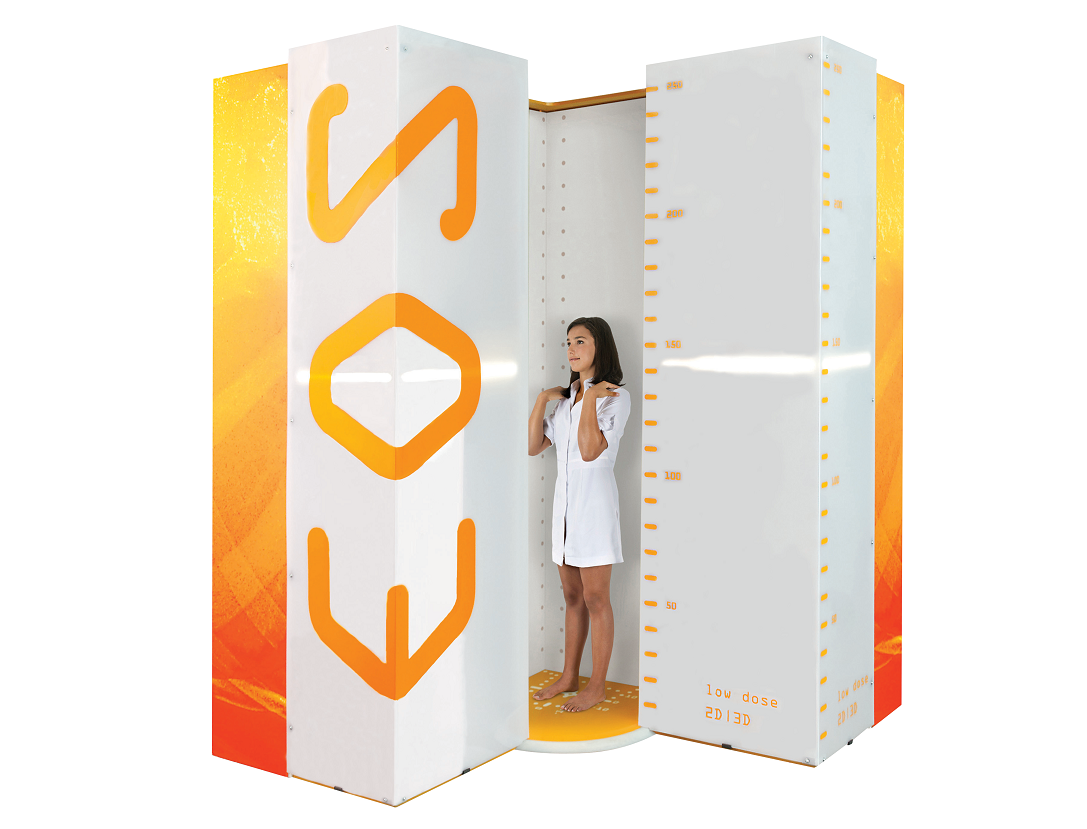Children’s offers a low dose, 3D X-Ray imaging system — the EOS system® — that uses 50 to 80% less radiation than a typical X-Ray. This enables us to provide As Low As Reasonably Achievable (ALARA) imaging, which means it limits your child’s exposure to radiation to the lowest and safest amount possible to still get the results we need.
With EOS, our physicians can make an informed diagnosis and develop treatment plans for your child’s spine, hip, or knee condition. Children’s is the only hospital in Nebraska offering EOS imaging.
The Benefits of EOS Imaging

EOS is especially helpful for children who require frequent medical imaging. The Micro Dose setting reduces radiation significantly more. One Micro Dose exam is similar to one week of natural radiation on Earth.
Fast and Easy Exams
We aim to make your child’s experience with us as comfortable as possible. During the exam your child will hold still in a standing or seated position. There is no lying down or turning over. Your child will remain still for up to 20 seconds while the scan takes place.
Diagnostics and Image Accuracy
An EOS exam captures two X-ray images at the same time – one from the front and side. For certain conditions, a 3D model of your child’s spine or lower limbs can be developed. 3D models provide our physicians with accurate measurements that can be used to make an informed diagnosis and develop treatment plans.
What is EOS Imaging Used For?
The EOS system is primarily used to assess patients with spine, hip and leg disorders. Because of the low radiation dose, EOS is ideal for progressive conditions that require frequent medical imaging, such as scoliosis.
EOS is not typically used for injuries that can be evaluated with general radiography, such as broken bones in the arms, legs, hands or feet. Traditional X-rays are still the standard of care for diagnosing these injuries.
Common spine disorders that EOS can be used for include:
- Spine curvature (scoliosis)
- Early onset scoliosis
- Adolescent idiopathic scoliosis
- Round back (kyphosis)
- Flat back (lordosis)
- Slipped vertebra (spondylolisthesis)
Common lower limb disorders that EOS can be used for include:
- Leg length differences
- Angular deformities from growth, trauma or infection
- Bowed legs (varus misalignment)
- Knock knees (valgus misalignment)
- Torsion abnormalities
In most cases, EOS exams will be scheduled by your child’s orthopedic physician. If the Orthopedic provider determines that an EOS exam is appropriate, the patient will be sent to the Radiology Suite located in the department of Orthopedics, SPC 4th Floor.
If you feel your child would benefit from an EOS exam, please contact Children’s Orthopedic at 402-955-6300 to make an appointment for your child. Patients do not need a referral to see one of our orthopedic specialists.
What to Expect
During the Exam
An EOS exam uses two very fine X-ray beams that can capture both front and side images at the same time. Your child is required to stand or be seated while the EOS system scans their body.
The EOS system can image the entire body in less than 20 seconds and can reduce the total procedure time to about four minutes.
After the Exam
After the exam, you will return to the clinic area where your child’s orthopedic physician will review the results and complete your child’s exam.
There are no special instructions for your child to follow after the procedure is complete.
Test Results
The images from the EOS exam are available immediately. In some cases, the physician will order a 3D model to view detailed information and reliably measure anatomical parameters. 3D models can take up to 72 hours to be generated. Once your results are ready, a report is sent to your physician who will then discuss the results with your family and determine next steps.
What To Do Next
For Patients
For children needing to be evaluated, please contact Children’s Orthopedic at 402-955-6300 to make an appointment for your child. Patients do not need a referral to see one of our orthopedic specialists.
If you feel your child would benefit from an EOS exam but is not a current Orthopedic patient, please contact their primary care physician. Their primary care provider can submit an EOS exam order.
Once an EOS exam order is placed, call 402-955-6799 to schedule the exam. On your scheduled appointment day, you will check in on the SPC 4th Floor, where your exam will be completed in the Radiology Suite located within the Orthopedic department.
For Referring Providers
The Physicians’ Priority Line is your 24-hour link to pediatric specialists at Children’s for referrals, emergency and urgent consults, physician-to-physician consults, admissions, and transport services. Call 855-850-KIDS (5437).
Learn more about referring patients.